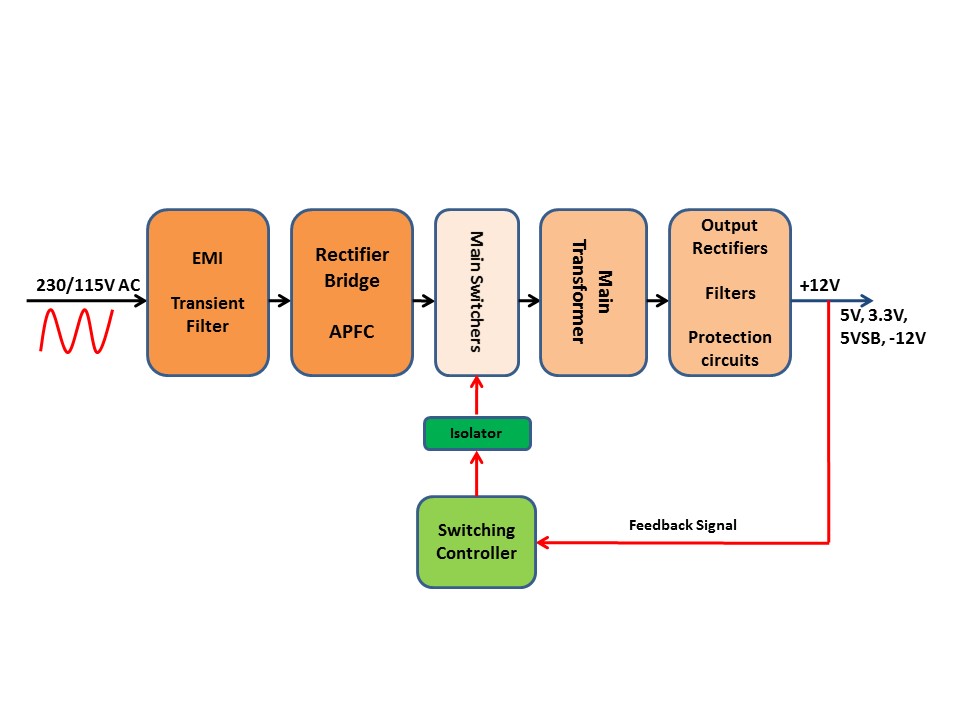PSUs 101: A Detailed Look Into Power Supplies
The objective of this article is to provide detailed information about the most crucial part of a personal computer (PC) system, its power supply unit. Follow us on this journey into PSU territory and we promise that you will gain valuable knowledge.
SMPS Parts Description
Any PSU that powers a PC nowadays utilizes switching power conversion (SPC) technology. The principle of SPC is quite simple, but for those who are still having a hard time understanding it, here's what it comes down to: energy is drawn from the power grid, and then it's chopped with a high-frequency rate into smaller energy packets with the use of some fast switches (FETs), and finally, it's transferred with the help of components like capacitors and inductors. In the end, all of the energy packets are merged, and after some rectification processes, energy flows smoothly from the output.
So, the PSUs in today's PCs use a 100 to 230VAC power stream as input (alternating current, or AC, main input differs according to country or region) and several regulated DC (direct current) outputs (these, of course, are always the same regardless of the country or region). As the switching frequency rises, the size of the energy packets gets smaller, thereby reducing the size of the components (inductors and capacitors) that store and transfer them. Any PSU that utilizes SPC is called a switching mode power supply, or SMPS, and with the abbreviation PSU in PCs, we assume that it is also an SMPS.
The figure above shows the block diagram of an SMPS used in a contemporary system. The first stage is the EMI/transient filter, followed by the active power correction factor (APFC) converter, the main switchers and the power transformer, and finally the output rectification and filtering stage. Between the DC outputs and the main switchers is a voltage feedback loop that constantly checks the output voltages (rails) and makes the necessary corrections by controlling the duty cycle of the main switchers. The pulse-width modulated (PWM) control is implemented by an integrated circuit (IC) that, in some cases (mostly in low-end PSUs) also controls the APFC switchers. However, in some resonant topologies, PWM is used only at light loads and forward modulation (FM) is utilized for higher loads. So, for the APFC switchers, an independent PWM controller has to be used. The part of an SMPS before the power transformer is called the primary side, and the part after it is the secondary side. These two sides must be isolated, but there must still be a type of connection between them in order to pass feedback signals. Usually, optoisolators or optocouplers are used for this purpose.
The two major advantages an SMPS has over a linear power supply (or linear regulator) is that its design is much smaller and lighter, and more efficient. The best SMPS designs can easily exceed 90 percent efficiency and, in some cases, reach up to 95 percent efficiency with 230VAC input. On the other hand, the most significant drawbacks of an SMPS are its complexity and its production of EMI, or radio frequency interference (RFI), that requires an EMI filter (also called the "transient filtering stage" because its role is twofold) and RFI shielding.
In the following sections, we will analyze all of the individual stages of an SMPS, or PSU as we call it from now on.
Get Tom's Hardware's best news and in-depth reviews, straight to your inbox.
Current page: SMPS Parts Description
Prev Page SMPS Vs. Linear Regulators Next Page EMI/Transient Filtering Stage
Aris Mpitziopoulos is a contributing editor at Tom's Hardware, covering PSUs.
